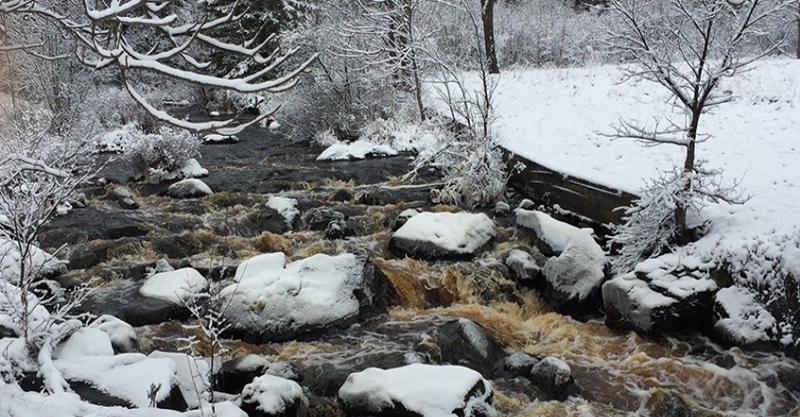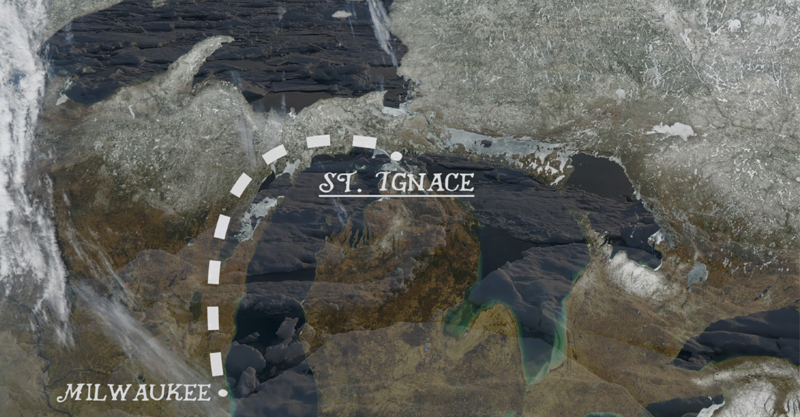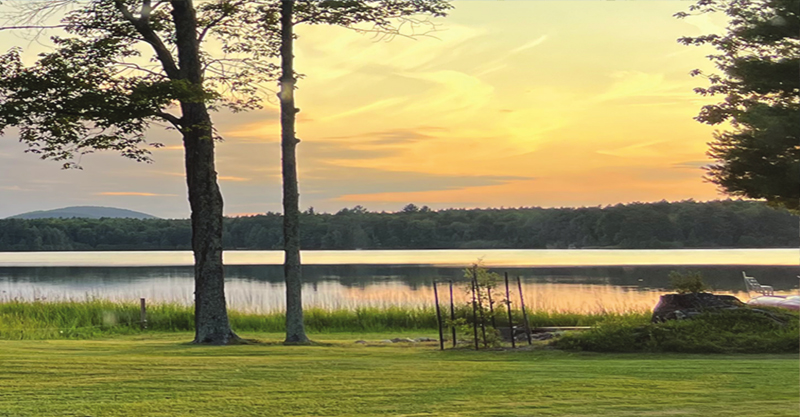from Marquette Monthly December, 2013
By Jon Magnuson
Today marks our winter’s first snowfall. Late afternoon. I’m standing with a steaming mug of arabica from Dead River Coffee alongside a statue of Father Jacques Marquette, twenty-four feet high, cast in bronze, originally erected in 1897 near our city’s Lighthouse Park.
It’s one of three replicas, the first of which was commissioned by the Wisconsin Legislature for inclusion in Washington D.C.’s Statuary Hall. In 1913, this modest, elegant piece of sculpture, crafted by a little-known Italian-born artist, Gaetano Trentanove, was transported to its present site. The statue now perches prominently in a small picturesque park on South Front Street alongside our community’s Chamber of Commerce.
I’m here on a short break. I’ve been conducting an informal poll with passersby and a few local folks working in various shops and nearby public buildings. I ask the following three questions: What do you know about Father Jacques Marquette? Are you aware when he lived? Do you have any idea why the city was named after him?
So far, a sample of answers from various individuals including two clerks from a nearby retail store, a hairstylist, a city worker, and two young twenty-somethings passing by included: “I think he founded the city of Marquette.” “Wasn’t he a Catholic bishop?” “He lived in the 1900s.” “I think he was from Poland.” “I have no idea who he was.” “I’m pretty sure he lived in the eighteenth century.” “Wasn’t he from Germany?” “I think he was born in this area. Didn’t he start Marquette University?”
None of these responses is accurate historically, but there’s no surprise or bewilderment on my end. We live unapologetically, some of us comfortably, in a sanctioned age of Internet overload, unfiltered data streaming, and celebrity obsession. Many of us know more about Kim Kardashian or Brett Favre than members of our extended family, much less our neighbors. As for more remote historical figures like Jacques Marquette? Unless you’re a history buff or a volunteer with the local regional history center, you probably don’t know much.
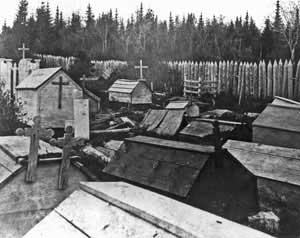
Admittedly, I hold a slight edge. For five years my family and I lived in a parsonage just off State Street in St. Ignace, a still-small town of barely 2,500. Just a few years after Jacques Marquette’s death in 1675, it was a thriving community of 200 French settlers and more than 6,000 Huron, Ottawa and Ojibwa Indian people. On occasion I roamed forest trails on the south side of St. Ignace, stumbling upon ruins I was told marked the site of forgotten Fort de Buade. Often, I strolled by popular souvenir shops, next to the ferry docks, stocked with tomahawks and feather bonnets made in Korea and China.
During that time, Prentiss M. Brown, Jr., an attorney and an informal leader with our faith communities in the area, was a key supporter for Mackinac County’s Historical Society. The summer before my family and I moved to Wisconsin, I assisted him in inviting a drum group from the Sault Ste Marie Tribe of Chippewa Indians to join an annual summer reenactment of the seventeenth-century landing of Father Jacques Marquette at St. Ignace. It was intended to be a commemoration of the French Jesuit’s arrival there to establish a mission with a band of Ottawa and Huron refugees who were fleeing from the west shores of Lake Superior under threat of hostile Lakota.
These days, a tribal casino looms on the north side of St. Ignace. Tax revenues are up and there’s been an economic development initiative to add more attractive, historical backdrops for commercial buildings framing the harbor’s edge. Ferry lines carrying visitors and supplies to Mackinac Island are as busy as ever.
At the same time, indigenous traditions are mostly forgotten. The original Anishinaabe language spoken fluently less than a hundred years ago by descendants of the first Native Americans who lived there, has now, for all practical purposes, disappeared.
What we know about Jacques Marquette
Between 1611 and 1775, more than 400 Jesuits came from France to North America to establish what came to be called the “forest-roaming church” among Native peoples in the New World.
Known as “Black Robes” by American Indians, their explorations and travels led them from the eastern coast of Canada, north to Labrador and Hudson Bay, west through the Great Lakes Basin, then south into the prairies of Illinois and down the Mississippi River into Louisiana.
As part of Jesuit tradition, these highly disciplined priests were cross-trained as botanists, cartographers, physicians, linguists and teachers. They kept careful records of their experiences. Those official reports during the period between 1632-75 are known as the “Jesuit Relations.”
Historical records tell us that Jacques Marquette was born in Laon (France), in 1637 and entered the Society of Jesus (the Jesuit Order) in 1654. He spent time in Montreal and Quebec learning Native languages (Anishinaabe), then was sent to La Pointe, near Ashland (Wisconsin), where Bishop Frederick Baraga, two hundred years later, also began his Lake Superior ministry. From La Pointe, Marquette traveled to Sault Ste Marie, then to Mackinac Island in 1671. Later that same year he established the mission at St. Ignace.

Marquette left St. Ignace in May of 1673 on a journey with the French government’s emissary, Louis Joliet. During that era official expeditions representing France brought with them a priest. Both men were, accordingly, commissioned to explore the southern Great Lakes Basin. Marquette returned to Green Bay for the winter of 1673-74, then traveled back to work with the Native peoples in what is now Illinois.
Those explorations are recorded as a part of the “Jesuit Relations.”
In April, 1675, Marquette began a canoe trip with a small band of Native companions along Lake Michigan’s eastern shore, intending to return north to the mission at St. Ignace. He was suffering from typhus and sensed his life was coming to an end. He desired to return to his Jesuit colleagues at St. Ignace in order to end his life with that community.
He died of illness just north of what is now known as the Pere Marquette River near Ludington. He was thirty-eight years old.
Two years later, a delegation of Indians brought Marquette’s bones back to St. Ignace to be buried, as Marquette had requested, in the old mission chapel. JacquesMarquette’s remains now rest under a monument built in his honor in St. Ignace (the settlement he originally named after the founder of the Society of Jesus, Ignatius of Loyola).
And what we don’t know
Historical documents give us very little insight into the personality of Jacques Marquette. In his journal entries, reflections on his personal life are obscure. What we do have is a historical context and some intriguing perspectives on the spirit of the Jesuits.
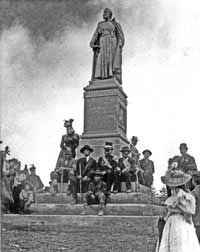
One of the best sources for Roman Catholic history in the Upper Great Lakes is Regis Walling, a retired teacher, archivist and writer, still very active in the Catholic Diocese of Marquette. She is well-known as the respected editor, along with Daniel Rupp, of The Diary of Bishop Frederick Baraga, published in 1990. Over the years, I’ve come to know her as a participant in an interfaith group of clergy, priests and laypeople who meet weekly to ponder scriptural texts used for preaching and teaching in local parishes.
Over coffee, on a late morning at her modest lakeside home, filled with books and her two cats, we shared thoughts about the recently elected Pope Francis I. A Jesuit from Argentina, the new Pope has shaken Catholicism with prophetic statements from Rome.
In interviews he suggests church sanctuaries be turned into homeless shelters and that economics have become the real “god” of modernity. He has led public prayers in hopes of preventing the United States from taking unilateral military action against the Syrian government. In recent weeks he asked for the resignation of a German bishop who spent hundreds of thousands of dollars renovating a personal residence. The bishop in question was known regularly to fly first class on airlines. Pope Francis ordered him to travel to the Vatican by coach class.
“When it comes to Jacques Marquette,” Walling says, “what we know from his writings is that he was deeply devoted to an understanding of the importance of Mary, the mother of Jesus. His was a life of prayer, discipline and compassion. He had an element of fearlessness about him. He was single-minded in devotion, dedicated in practical as well as spiritual matters, to improve the quality of life among the Native people with whom he and his fellow Jesuits lived.”
We continued our conversations about the complexities of religious life, the relationship of social justice to the Gospels, and the tensions that often surface between Jesuits and local bishops who, by virtue of institutional responsibilities, are often conservative.
As I rose to leave, she smiled and said, “If I were a man, I would have chosen, I think, to be a Jesuit.” I replied, carrying a stack of books she was lending me under my arm, “Regis, you are one.”
Later that night, I read in depth about the Jesuit mission at Mackinac from 1670 to 1795 in an historical overview written by James Boynton, who grew up in St. Ignace, now himself a member of the Society of Jesus.
Boynton describes how Antoine de la Mothe Cadillac, a flamboyant military leader overseeing France’s interests in the New World, came into conflict with the Jesuits who followed Father Marquette at the mission in St. Ignace.
Boynton observes, “Each party was ardently loyal to both Church and Crown, but while one measured success in terms of docile converts, the other sought means of economic profit.”
Boynton states that a few years following Marquette’s death, Cadillac, in frustration over the Jesuits’ objection to brandy being sold and often given to Native peoples to help French trappers better leverage the lucrative fur trade, describes an encounter with Father Etienne de Carheil, a Black Robe assigned to the Mackinac mission. In his report to Quebec, Cadillac wrote:
“The Jesuit told me I was putting on airs, and at the same time he shook his fist under my nose. I tell you, Monsieur, that I almost forgot that he was a priest, and was on the point of breaking his jaw. But thanks be to God, I contented myself with taking him by the arm and leading him out of the fort, telling him to stay out of it in the future.”
Boynton astutely observes, “Cadillac’s interest in the region’s fur trade, of which he was given control following 1705, caused him to overlook abuses of the law about the brandy trade, (at that time a statute for New France initially requested by the Jesuits, and supported by the King).”
An Unfinished Legacy
Jacques Marquette, priest, explorer, mystic and devoutly zealous spiritual leader, was, in his time, part of a larger shifting paradigm. The opening up of New France was a dramatic, fast-paced transitional period for North America, not unlike what our own generation is facing with an increasingly volatile global economy, a shift away from dependence on fossil fuels, new communication networks and the haunting specter of climate change.
Historically speaking, the Jesuits, during Marquette’s time, were deeply committed but often ridiculed, perhaps rightly so, for their single-minded missionary zeal apparent in their counting baptisms and conversions.
They are lesser known, unfortunately, for their fierce advocacy and defense of the physical and economic well-being of Native peoples to whom they had devoted their lives.
The tension between the French Crown’s insatiable desire for an expanding fur trade and the Black Robes’ concern for the welfare of Anishinaabe essentially was a high-stakes debate about competing visions for a New World. It involved economics, but equally important, the dignity of an indigenous population and deeply held differences of opinion about what makes a “good life.” In their time, as in ours, it was no easy equation.
The spirit of a lone Jesuit priest, whose cast bronze image stands in a park over-looking Marquette’s Lower Harbor, is a benign, irrelevant piece of art for most citizens. It doesn’t have to be. The Great Lakes Basin, more specifically the future of the southern shores of Lake Superior, is in contentious debate as it has never been before.
A member of the Marquette City Commission confirmed, days ago, that international corporations have identified thirty-three new potential mining sites in Baraga and Marquette counties. Jeffrey Loman, retired federal oil regulator who for years worked with the government in Alaska, and a member of the Keweenaw Bay Indian community, commented last week that local elected officials have found themselves having to make decisions whether or not we will allow ourselves to live in another North America “sacrifice zone.”
As an international foreign mining company threatens to confiscate private lands to build haul roads, and is about to begin operations on a sulfide mine that promises to extract $8 billion of copper and nickel, there remains significant evidence of potentially devastating environmental damage to our public lands and waters. Such companies are first to admit, unabashedly, they have one bottom line: financial profit. Earlier this year, when Rio Tinto found it inconvenient and problematic to continue developing the Eagle Mine, in spite of promises of being good neighbors, the company left town.
The mine’s new Canadian owners are underwriting a media campaign, giving away thousands of dollars to businesses and nonprofits and making similar promises. Increasing numbers of citizens and tribal communities from across Michigan’s Upper Peninsula, in the spirit of the Jesuits, are saying, “Not so fast.” They are monitoring every proposal and regulation, making their voices heard at public hearings and city halls.
Connecting our Past to a Future
The next time you travel north from Lansing into the Upper Peninsula, as you drive over the Mackinac Bridge, that five-mile long magnificent example of suspended steel and cable, carry with you these two images.
The first is a chalice. After Marquette’s death in 1675, we know his bones were removed of all flesh, as was the custom of the Odawa and Huron, then carried by canoe north to be buried in St. Ignace.
Dan Rydholm, a social worker with degrees in divinity and sacred theology, mentioned to me not long ago something not known to most of us: the chalice which Marquette used in his ministry, and carried with him in a canoe during his history-making explorations during the seventeenth century, initially was kept by the Native peoples who loved him.
It was two hundred years after the French left the Northwest Territories when a group of Native American descendants brought the chalice back to the mission at St. Ignace. Now, each winter it resides at the University of Detroit, a Jesuit institution. Each summer the chalice is returned to the museum in St. Ignace, carried in secret, in car or truck by an anonymous courier, across the Straits of Mackinac.
The second is an image shared with me early this fall by a member of the Sault Ste. Marie Band of Chippewa Indians.
When the Mackinac Bridge was dedicated in November of 1957, a film was made. The closing scene was shot from a helicopter. It was of a single tribal dancer from his community, dressed in ceremonial regalia, holding an eagle feather, circling to the sound of a drum high on top of one of the bridge’s two 552-foot towers.
History reminds us we are all passing through––one generation at a time. There are decisions to be made. We can choose to measure the quality of our lives with lasting values, not simply by economic standards.
We can remind each other that we live at the edge of one of the last uncontaminated freshwater lakes in the world, a landscape rich, unique, where moose, bear and wolves still roam the backcountry. We can choose to measure the value of communities with standards that resonate more with the human heart: By the simplicity with which we live and how we protect our wilderness areas; how we celebrate farmers’ markets and art festivals and invest in our faith communities; how we encourage innovative education projects, protect rare plants, build gardens, and support local businesses that creatively and responsibly use sustainable natural resources.
We have the option to live more boldly, choose to become less urban. We can be an example, here in the Upper Peninsula, of a unique, modern, village culture for the 21st century.
A few weeks ago, I joined a group of volunteers who were meeting on Mackinac Island as part of an interfaith environmental initiative. As eighty-seven-year-old Clare Harder reminded a group of us seated in a circle in the basement of the Island’s historic St. Anne’s Catholic Church, “Why aren’t we talking about this? Building a life here in the peninsula that’s measured by more than economic prosperity, but instead a life of balance, proportion and beauty.”
It’s the kind of question a Black Robe might ask.
––Jon Magnuson
Editor’s Note: Jon Magnuson is director of the Cedar Tree Institute, a nonprofit organization based in Marquette. Alongside four Native American tribal communities, the EPA and the U.S. Forest Service, the Institute is working with Earthkeepers II, an interfaith environmental initiative to establish thirty community gardens across the Upper Peninsula and assist 250 faith communities in becoming better stewards of energy conservation.

